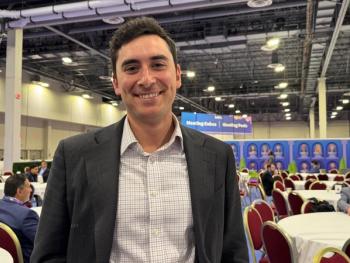
The AI genie is out of the bottle - and there’s no going back | Viewpoint
Without AI, no healthcare organization is going to be able to keep up with the amount of clinical documentation as more healthcare data is generated and jobs go unfilled.
Far too many media outlets today promote the dystopian view that AI is going to take all of our jobs. Unfortunately, blatant scare-mongering works.
Over the past three or four months, we’ve talked to dozens of health system technology decision-makers who acknowledge that AI can make their organizations more efficient and cost-effective. Each of them, however, express concerns that AI will “replace their people.” It’s the number one objection in the field.
There’s also a healthcare FOMO crowd, who is under pressure from leadership to do something, anything, with AI. Everyone is doing it! We can’t be left behind!
Many healthcare decision-makers plagued with FOMO are also skeptical of grandiose claims regarding the ways AI will transform healthcare. These healthcare veterans have heard it all before; they must implement a certain technology to keep up with their peer organizations. Growing immune to the hype and buzz around these solutions, the looming need for digital transformation remains.
With or without you
People in the fear and FOMO camps need to take a deep breath and recognize that AI is happening with or without them. Provider organizations that fail to implement a successful AI strategy will fall behind because their understaffed workforces are already buried under a backlog of clinical administrative tasks.
A recent survey of healthcare workers paints a picture of understaffing, burnout, and lack of job satisfaction. Nearly six in 10 (58%) responding to a
To make matters worse, a
Here’s the reality: Without AI, no healthcare organization – whether it’s a skilled nursing facility, a primary care practice, a children’s hospital, etc. – is going to be able to keep up with the amount of clinical documentation as more healthcare data is generated and jobs go unfilled.
While provider organization leaders may worry about AI being used to replace humans, healthcare workers are more likely to welcome the help that AI can provide. In the February survey of healthcare employees cited above, 77% of respondents said emerging technologies like AI could be useful in combating the worker shortage.
Eliminating ‘pajama time’
There’s a far more reasonable and prudent approach to AI implementations that will optimize the return on investment for hospitals and health systems while providing a blueprint for future successful AI initiatives: Providers can seek out pragmatic, safe ways to apply AI right now that are affordable and designed to ease the administrative burden for clinicians.
Ambient listening is a good example. Physicians typically spend between 30 and 90 minutes after hours – known as “pajama time” – completing clinical administrative work they were unable to finish during the day while seeing patients. Having ambient listening functionality that can perform clinical documentation tasks vastly reduces clinician workloads and burnout while improving efficiency and accuracy.
Another use case for AI in healthcare is abstracting data from electronic health records (EHRs). On average, it takes an abstractor one hour to finish the abstraction work for a single case. That’s a lot of costly time. The right AI technology, however, can perform abstractions for thousands of cases in minutes. Why wouldn’t a hospital or health system embrace this opportunity?
AI is a tool that you control
Humans have a tendency to overreact, especially when exposed to hype and doomsaying. That’s why we hear from provider organization decision-makers every day who still are afraid of AI and what it will do to healthcare jobs – even as understaffing remains endemic.
That’s why it’s important to remember where AI fits into your provider organization. AI is not a separate thing, and using it doesn’t suddenly make you an AI organization.
AI is just better software algorithms than you already have. When you look at it that way, it’s not so scary! AI is a tool and it is part of a process. It’s also familiar: we use AI every day in our regular lives, whether it’s through our computers, smartphones, smart televisions, or other connected devices.
AI is going to help clinicians do more with the time they have. It will help physicians, nurses, coders, and clinical data abstractors by automating simple but necessary tasks. It will also help provider organizations improve efficiency, reduce costs, and enhance care quality. What AI will not do is replace medical professionals.
Conclusion
There is a massive shortage of physicians and nurses predicted to get worse as the U.S. population ages and the demand for care services increases. Provider organizations would be irresponsible not to deploy AI in ways that enable their clinical staff to optimize their care for patients.
The AI genie is out of the bottle. It’s not going back in.
Greg Miller is VP of business development at Carta Healthcare and Jeremy Bikman is president at Reaction Data.








































